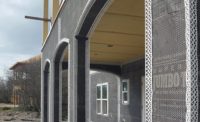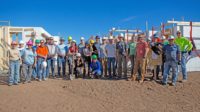I am here to talk about times when what you see is not what you get. It is a sad fact that sometimes things are not what they are supposed to be. It happens in almost every aspect of life but my concern is in what we do. We are the walls and ceilings industry. We are lathers, plasterers, framers, rockers, EIFS mechanics and acoustic carpenters.
In our industry, as well as almost every other industry, the quality of every component in an assembly is governed by a group of people that give their time for the constant testing, testing methods and the quality of the products used. This is the American Society for Testing and Materials.
This society is made up of a membership of engineers, scientists, architects, consultants, industry experts, contractors and yes, even plastering subs like myself. We are the guard that sits at a post while others sleep. We make sure what is produced for use in construction has been tested to the standards we require for a particular test method. All members have a vote, yes, no, abstain and the opportunity to comment. One “persuasive” negative vote may stop a ballot. It may be modified in verbiage, or on technical issues and re-balloted or stopped in its tracks completely. I bet you that the gargoyle that fell in Chicago in September is being investigated by someone involved in the ASTM. It may be one of the engineering firms specializing in concrete and/or attachment methods.
As with life, construction and its components are constantly evolving for the better. Much of the change is in direct relation to what many members of the society do. I install lath and plaster and have experience in proven means and methods. Many other members are forensic scientists or engineers. They specialize in “what went wrong.” (Excuse the pun but it is relevant to this story.) They investigate failed structures, why it failed and what to do to make sure it does not happen again.
All U.S. Building Codes reference the ASTM for construction, and enforcement is at the hands of the designer and code officials. I would like to think that I build better and almost everybody wants to build something to be proud of. This doesn’t always happen. Look at the past years and the three building collapses in India and now one in China.
Foreign vs. Domestic
Manufacturing in the U.S. must meet the standards of the ASTM in building products, down to the size of the threads on any particular screw size. Even the pull-out resistance is tested. Manufacturing of metal lath has specifications as well. This is governed by the C847 Standard. The installation is dictated by the C1063 and plaster by the C926.
Back in the mid-’80s we had an influx of lath products from South Africa. Many state and federal projects did not permit them in the project. They were underweight and/or did not meet the minimum standards of the code. This works fine for a project requiring you to submit product data to the architect for approval, but a large percentage of jobs do not require a submittal. The building official or owner may not know any different. If it’s round and orange in color, it must be an orange. Products were consumed and installed. One of the biggest problems in my business was the channel iron we used for suspended ceilings was so light in weight that when the plaster was installed the channels rolled onto their sides.
The issue we now face is imports from foreign mills in the Far East. OK, let’s say it’s China. Although I am also in the material supply business, I have been contacted direct as a contractor to buy straight from the Chinese mills. They want to sell me EIFS mesh and recently two different lath manufacturers wanted to sell me container quantities.
I was contacted by a man named “Jack.” I inquired about his product and he said not to worry, it complies with the ASTM Standards. I asked how so? He stated the lath was 27 inches in width and 96 inches in length. He produced a copy of the 2009 edition of the standard. I, being somewhat arrogant (some say) and from the south, I had to jab a bit at his material.
As a voting member of the C11 Committee, I know of changes in the codes yet to come, items currently being balloted and what is being considered for change. I told Jack that his material was not compliant because the C847.4.3 states the length of lath shall be 97 inches. ASTM C847.4.5.3 goes further to say the length must be minus 0 inches and plus 1.5 inches. I also reminded Jack that reproduction of copyright material was a violation of U.S. laws, the 2009 Edition was outdated and if he did not believe me I could refer him to hundreds of other professional that were responsible for this change. Having “hooked” Jack, I had to show him the fighting spirit of an Irishman. I asked if his material met the minimum galvanization of G-60 and if China’s test methods were consistent with those of the U.S.? He said he could produce an Evaluation Service Report. I am sure he could but after a few emails I got the impression it was much like getting a bad haircut and the barber telling you it looks great. He was a good sport through it. His last transmission thanked me for my “teachings.”
All in All
Some of you old timers, and I am considered one now, may remember when lath was 98 inches. I do and I don’t know why it was lowered. Maybe because Americans always like to give the other guy a chance and 96 inches would fit into a cargo container. The length was increased because with most framing 16 inches and 24 inches-on-center; it was necessary to lengthen the lath to fall onto the studs completely for attachment and also meet the requirements for lapping at the ends. This is especially true in hurricane prone zones and areas with high seismic activity. Yes, the lath can be tied or laced, but always cautious, the members also consider the safety factors for the population. Who wants a chunk of plaster to be pulled from the wall in a wind storm? The changes come for the better, not hidden agendas.
In conclusion, cheap is seldom better. My philosophy is do not value engineer your roof, your foundation or your wall assembly. (To anybody that does not know the word VE; I first heard it about 20 years ago. It means, “What can we discard or do cheaper to save money.”)
In construction, you can only cut three corners—once you cut the fourth you have a circle and a circle always comes back to you. Material quality is not a corner to cut. Know the products you purchase or sell. Make sure they are labeled and compliant with codes. This will provide for a better end product. I strongly encourage anybody that has the interest in our industry to join the ASTM. You can be a part of something positive, support our industry and the cost is minimal.
For more information about the society go to astm.org.








Report Abusive Comment